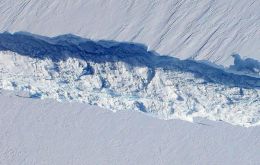MercoPress. South Atlantic News Agency
Tag: Pine Island Glacier
-
Tuesday, September 26th 2017 - 18:45 UTC
Jumbo 100sq-miles iceberg breaks off from Pine Island Glacier in West Antarctica

An enormous Antarctic glacier has given up an iceberg over 100 square miles in size, the second time in two years it has lost such a large piece in a process that has scientists wondering if its behavior is changing for the worse.
-
Friday, April 25th 2014 - 23:19 UTC
NASA and BAS tracking major Antarctic iceberg, B31, now in open waters

NASA has lately spotted a gigantic iceberg in Antarctica, identified as B31 and together with UK's BAS (British Antarctic Survey), is busy tracking the monster island of ice, which has now escaped into open waters. Despite its sheer size and mass, --experts estimate that the giant iceberg is approximately 600 square kilometres in size--, monitoring is not going to be an easy task with the coming of the Antarctic winter and ensuing darkness.
-
Thursday, November 14th 2013 - 19:20 UTC
Two UK scientists keeping track of Manhattan size iceberg moving in the Southern ocean

An Iceberg, the size of Manhattan in area, was derived from the Pine Island Glacier, and is currently moving through the Southern Ocean. To keep track of its movements and melting Professor Grant Bigg of UK's University of Sheffield has been awarded a £50,000 grant from the Natural Environment Research Council (NERC) for the 6 month project.
-
Thursday, July 11th 2013 - 07:08 UTC
Eight times Manhattan island iceberg breaks off from Antarctic glacier

Pine Island Glacier (PIG), the longest and fastest flowing glacier in the Antarctic, has spawned a huge iceberg. The block measures about 720 sq km in area - roughly eight times the size of Manhattan Island in New York.
-
Monday, October 15th 2012 - 22:06 UTC
NASA IceBridge on its fourth edition to study Antarctica’s polar ice changes

Scientists and flight crew members with Operation IceBridge, NASA's airborne mission to study Earth's changing polar ice have started another campaign over Antarctica. Now in its fourth year, IceBridge's return to the Antarctic comes almost a year after the discovery of a large rift in the continent's Pine Island Glacier.
-
Friday, November 4th 2011 - 01:06 UTC
Prepare for a huge iceberg, 880 sq kilometres anticipated NASA

A massive crack is growing wider in the Antarctic ice sheet and could break apart in the coming months, forming an iceberg the size of the island of Lanzarote (Canary Islands, Spain), NASA scientists warned Thursday.
